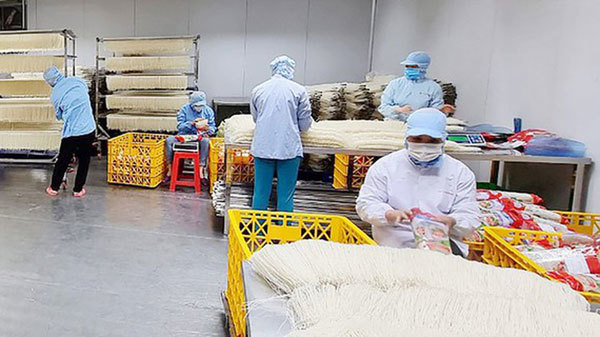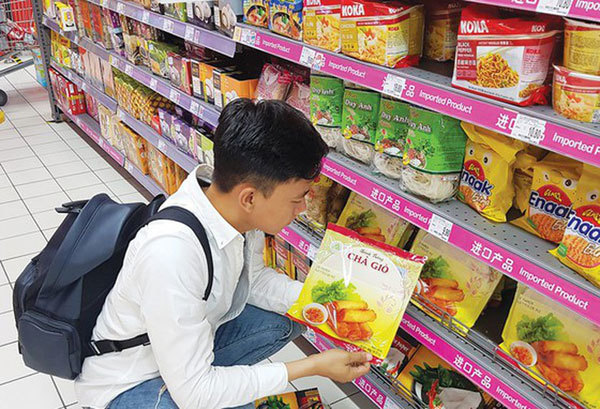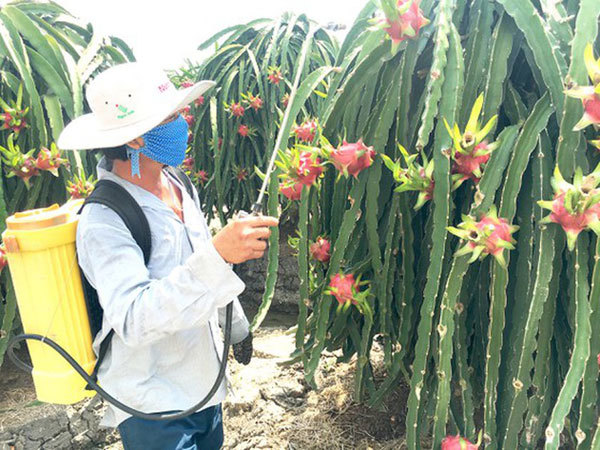Many business owners confidently affirm that they are on the right track and have initially succeeded in conquering the world market.
 |
| Workers pack watermelon and dragon fruit vermicelli products of Duy Anh Company for export to the US and European markets. (Photo: SGGP) |
The story of Duy Anh Company is a typical example. Mr. Le Duy Toan, CEO of Duy Anh Company, said that since the very first years of his abroad study in the US, he saw a lot of Vietnamese specialty products. There were even traditional products that can only be produced in Vietnam, such as rice paper, pho noodles, and vermicelli. However, in the US supermarket system, they originated from other countries, namely Thailand and China. Because of that, he had cherished a dream of bringing Vietnamese goods under Vietnamese brands into the US supermarket systems. However, if the company starts producing products without knowing the standard requirements, quality, and consumer tastes, partners will never accept its products. Therefore, he chose the solution of outsourcing products for Japanese companies. This is the foundation for him to quickly approach and perfect quality standards and packaging of products. At the same time, he could grasp the consumer tastes of each market as a basis for developing Vietnamese-branded products.
Currently, the factory of Duy Anh Company has a capacity of about 800 tons of goods per day, and its products are relatively diverse, comprising watermelon vermicelli, dragon fruit vermicelli, white rice paper, brown rice paper, pho, and noodles of all kinds. According to Mr. Le Duy Toan, all the product lines produced by the company use domestic agricultural raw materials. Products are mainly exported to Japan, the US, and Europe. The US market is the main market with about 20 containers of goods per month. Especially, from the beginning of the year to now, the company has expanded to many new markets in the Middle East and Northern Europe.
Recently, many large-scale Vietnamese enterprises have appeared, and they have spread Vietnamese brands to many markets around the world. The passion fruit drink of Nafood Joint Stock Company is a typical example. Passion fruit is a quite common plant in the Central Highlands of Vietnam, especially in Gia Lai. Because it depends on raw export, the price of this agricultural product is extremely volatile, hovering around VND2,000 per kilogram. Sometimes, the price even drops to VND500 per kg. Therefore, farmers are not interested in growing this fruit. Mr. Nguyen Manh Hung, CEO of the company, said that situation has changed after the company processed this kind of fruit into a popular specialty drink in the US and European markets. Currently, Nafood Company has cooperated with farmers to establish specialized growing areas for passion fruit plants, and at the same time, invested in a processing plant here.
On a larger scale, Vietnam Dairy Products Joint Stock Company (Vinamilk) has brought Vietnamese milk and dairy products to more than 50 markets globally, including the contract to export a trio of soybean, walnut, and red bean milk products, worth US$1.2 million to the South Korean market. These are all “make in Vietnam” products that come from domestic agricultural sources. According to Vinamilk's representative, South Korea is considered the “capital” of the food processing industry, especially nutritional drinks. Foreign enterprises are often unable to penetrate this market because it is difficult for them to compete with local enterprises. The success of Vinamilk when exporting this shipment has indirectly confirmed the advantages and the high value of domestic agricultural products, contributing to opening a confident and firm direction for Vietnamese agricultural products in the near future.
Building international brands for Vietnamese goods
Vietnam is an agricultural country, so agricultural products are abundant and diverse. The situation of raw export for a long time has reduced the value of Vietnamese agricultural products. Especially, international consumers have been incorrectly identifying Vietnamese products. The strategy of building and developing Vietnamese brands in foreign markets, launched by the Ministry of Industry and Trade in 2017, has created a positive effect. Vietnamese products with Vietnamese brands have gradually gained a position for Vietnamese goods in the global market. As a result, the position of Vietnamese goods has been increasingly affirmed and firmly established in the supply chain.
 |
| Noodles and rice paper products of Duy Anh Company are sold at a supermarket in Japan. (Photo: SGGP) |
However, Mr. Nguyen Manh Hung said that to create a more sustainable direction for Vietnamese agricultural products, besides the policy of supporting investment capital, the Government needs to make planning for the raw material growing-areas again. Accordingly, the planned raw material growing areas must meet criteria, such as suitable soil, strengths of each province, and large-scale cultivation, to stabilize raw materials for the production of enterprises.
As for market management, it is essential to tighten control on the origin of goods and strictly handle the situation of low-quality and counterfeit goods labeled with Vietnamese brands, fight against foreign enterprises that violate intellectual property rights of Vietnamese brands, and agricultural products protected by geographical indications. Simultaneously, authorities should promote propaganda so that enterprises understand correctly and sufficiently about the registration of intellectual property rights, trademarks, and brands. This is the basis to effectively prevent the situation of vying with each other to buy and sell Vietnamese products in domestic and foreign markets, in which genuine Vietnamese enterprises suffer most of the damage.
“In addition, despite the same product, the consumer tastes in each market will be different. Therefore, enterprises should actively grasp this factor in order to have the appropriate preparation and processing of their products. More importantly, it is necessary to invest in research to create new products. Vietnamese agricultural products are very diverse and plentiful. Developing new products also means increasing market development opportunities for Vietnamese enterprises,” emphasized Mr. Le Duy Toan.
|
Analysis of the structure of export turnover from the General Statistics Office shows that in the first six months of this year, export turnover of goods was estimated at $157.63 billion, up 28.4 percent year-on-year. The group of agricultural and forestry products alone reached $11.58 billion, up 15.8 percent, and the group of aquatic products $4.05 billion, up 12.4 percent. The US continues to be Vietnam's largest export market, followed by China, Europe, the ASEAN, South Korea, and Japan.
|
Source: SGGP

Solutions needed for agricultural products to no longer call for rescue
Every time China stops importing agricultural products or when the Covid-19 pandemic happens, several agricultural products are unsalable, then the rescue of them to support farmers will take place repeatedly.

US surpasses China to become largest importer of Vietnam's agricultural products
With export turnover of $2.04 billion, the US surpassed China to become the largest consumer of Vietnamese agricultural products in the first two months of 2021.
